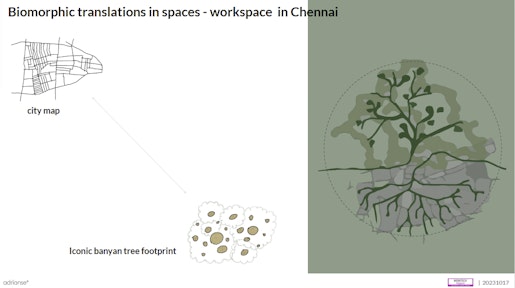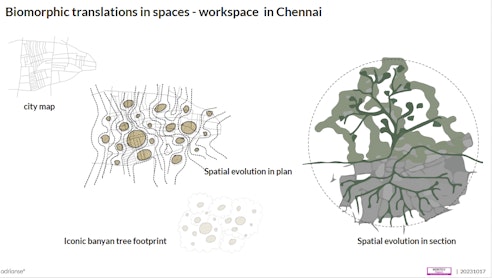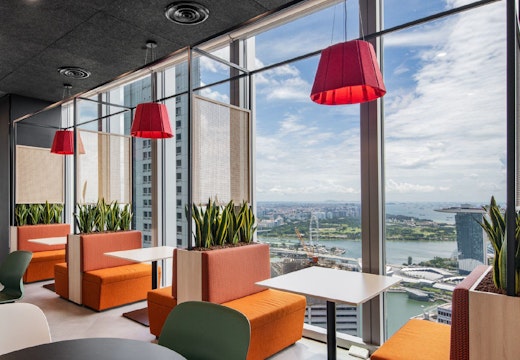Biomorphism: designing natural systems for natural ways of working
The links between biophilic design and human health are today well understood. But could a deeper engagement with natural systems through biomorphism generate greater wellbeing at work?
Ever since Roger Ulrich’s groundbreaking research in 1984 revealed that surgery patients in hospitals recover faster with external views of green space, there has been a wealth of research investigating the relationship between biophilic design and health.
Ulrich, then a professor of architecture at Texas A&M University, produced a ground-breaking study showing a marked clinical difference in recovery between 23 patients looking onto a natural setting and 23 with similar conditions facing a brick wall – results that influenced the construction of millions of hospitals around the wall. Inevitably, these findings would filter through to the evolving relationship between health and work.
From the relaxing effect that visible wood grain can have on a space’s inhabitants to the role of plants in improving productivity and gently curving pathways at helping us feel safe, research into biophilia has explored how the design of office spaces can impact our wellbeing and performance at work. This is often attributed to biophilic design recreating conditions that improved our quality of life during the early years of the human species – conditions that suggested that we were safe and had access to food and shelter.
‘Is a nod to biophilic design really enough to support the health of an entire organisation?’
As this research has entered public consciousness, it has become more common for organisations to incorporate a nod to biophilic design – a few plants here and some exposed wood there. But is this really enough to support the health of an entire organisation, and should designers be going further with their approach to mimicking the natural environment?
According to Adrianse director Chinmayee Ananth, ‘The way we think about health has changed since Covid-19. The drive to design wellness-compliant workspace is now very strong. But while such initiatives are expanding, too many are just transactional and programmatic. We need to think more deeply and conceptually about how healthy work can be defined from multiple perspectives.’
This article is the third in a series considering the multi-faceted relationship between health and work. It is a collaboration between global design firm Adrianse and WORKTECH Academy which seeks to explore new insights and connections. Adrianse has 11 international studios from New York and Milan to Singapore, Sydney and Bangalore. The firm has strong roots in the Asia Pacific region, notably India and Singapore, and brings a wealth of experience in designing and building workspaces, healthcare environments and data centres. Read the first introductory article here and the second article on the health challenges of hybrid working here.
Biomorphism – taking design further
There are many opportunities to think more deeply about the interconnections between natural systems and the built environment. Neri Oxman, a former associate professor at MIT Media Lab and now the architect and designer behind research organisation Oxman, has spent her career exploring how the built environment can more deeply mimic the natural world.
In Oxman’s manifesto, she argues that we need to ‘design to empower a future of complete synergy between nature and humanity’, suggesting that one way we can achieve this is through system-centric design which ‘considers any design construct—wearable, product, or building—a system of quantified interrelations across natural, biological, and digital domains’. This approach amounts to biomorphism – a step beyond biophilic design where the design of spaces and objects reflects more deeply the patterns and forms found in nature.
Taking up this provocation, we can ask:
- What would office spaces look like if they were designed with a biomorphic, system-based approach at their heart?
- How would the wellbeing of a building’s inhabitants be affected if we took a deeper, more holistic approach to the incorporation of natural elements into office design?
- How would our thinking about office spaces change if we viewed them and their inhabitants as an element of a wider natural system?

Image: Courtesy of adrianse
Biomorphism in practice
In the immediate aftermath of the pandemic, persuading people to return to the office was not an easy task. Employees felt at risk, believing that the office might not only compromise their health but also those that they lived with and interacted with daily. This made the office a place to be avoided.
Against this backdrop of anxiety, workspaces needed to be designed to put people at ease, provide comfort and create a sense of safety, not just on a social or functional level but on a biological level as well. How could this be achieved? One answer lies with biomorphic design, mimicking natural forms and connecting people with each other in an environment that support their natural behaviour.
Adrianse director Jayanth Gopal explains: ‘Biophilia is an over-used word and is generally applied too narrowly. More broadly it means “Love of life” and should have application in that context.’
This thinking is exemplified by Adrianse’s new design of the Pfizer’s Mumbai office. The design process is hinged around the idea of the office campus as a series of cells, not just introducing biophilic elements but using biomimicry and biomorphism to create an environment that reflects more deeply the natural environment and replicates natural systems.
Calm and natural
Mumbai went back to office work earlier than other Indian cities and Pfizer’s role in vaccine production gave it an uncomfortably high profile in the controversial debate about lockdowns and the return to office. So, the design brief was for Pfizer’s staff to return to as calm and natural a setting as possible.
Whereas earlier, in 2019, Adrianse had adopted the visual language of local culture and traditions to create an attractive Pfizer office in Chennai for 800 people, applying graphic patterns to walls for example, now the design team chose natural materials and textures for the post-pandemic Mumbai office.
Chinmayee Ananth, design leader on the project, explains: ‘Every element and detail was very natural and organic. Wood was not painted, for example. Nothing was treated to become something else. Floorplates revealed themselves as tendons or neurons. The aim was to create a calm narrative and a strong connection to the company in a way that was not forced.’
People want different settings in the office for focus work, collaboration, socialising, reflection and so on. So, while deeper adherence to natural systems can bring a general inspiration to the space, how can contrasting worker needs be addressed? Chinmayee Ananth likens the approach to the natural world itself: ‘You might want to have fun socialising on the beach with friends or cycle up a mountain path to have quiet time to reflect. The settings in a workplace in its most natural form should let you pick how you want to work.’
Consideration of lighting and acoustics is central to providing choice of workplace settings, whether that is linking patterns of shadow and light to the circadian rhythms of the day or providing both quiet spaces to concentrate and loud, buzzy spaces to socialise. Ananth observes that deep in the countryside, there can be quiet and loud spaces.
Adrianse’s Pfizer office in Mumbai embodies biomorphic design and thinking, creating a space which offers comfort on a biological level whilst also enabling productive work and utilising natural materials in its construction. By embracing natural systems and allowing them to be central to the structure of the building from the inception of the design, Adrianse is exploring a new type of post-pandemic office.
‘An increased sense of wellbeing to office occupants as part of a connected ecosystem…’
More broadly, a deeper engagement with the natural world beyond simply adding plants opens up new possibilities in the relationship between work and wellbeing. Taking biophilic design further has benefits for the health of people and planet, offering an increased sense of wellbeing to office occupants whilst also thinking of the workplace as part of a connected ecosystem which is designed to interact gently with the natural world around it.

Image: Courtesy of adrianse
The next article in this series will explore how cultural systems in the workplace contribute to human health, going beyond DEI (diversity, equity and inclusion) exercises as a tick-box exercise to engage more deeply and sensitively with an increasingly diverse workforce.








